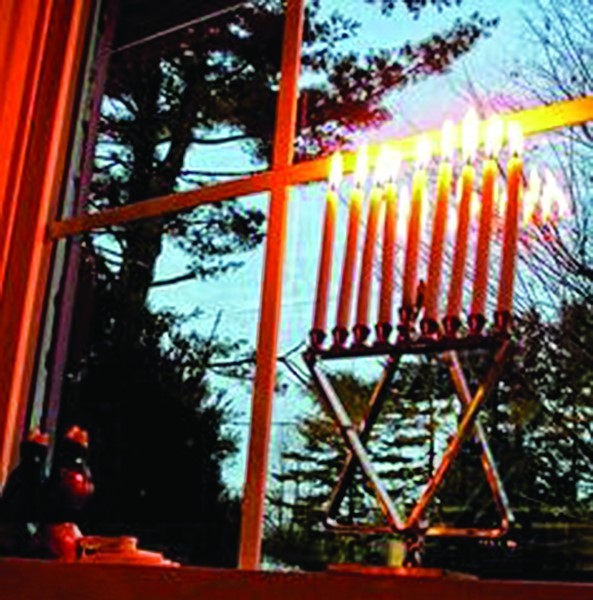Why I light my menorah in the window – and you should, too
BY
LOS ANGELES (JTA) – In the weeks before Hanukkah, with anticipation of the holiday brightly filling my mind, the darkening news of rising anti-Semitism in the U.S. began to filter in. As I pictured our menorahs burning in their usual place – the front windows of our home – a warning light began to blink.
Hanukkah represents a victory of light over darkness – by the Maccabees over the Seleucid Empire, which resulted in the rededication of the Second Temple – recent events were causing me to rethink our window menorah lighting, turning me toward sharing our menorah kindling with only family and friends.
But, like finding an extra Hanukkah candle in the box, a new U.S. Hanukkah postage stamp depicting a lit menorah in a window was an unexpected source of inspiration.
For 17 years we’ve lived on a block where there are no other Jewish families. We’ve proudly placed our menorahs – whether lit by candle or by bulb – in our front windows, publicizing the miracle of the holiday to our neighbors and ourselves. Saying the blessings and lighting the candles is a mitzvah, according to the Talmud, and by doing so, we were also recognizing the blessing of our freedom of religion and expressing our Jewish identity.
In fact, it wasn’t really Hanukkah for me until I walked outside and, looking at the light emanating from the menorah in my own window, affirmed that we had arrived to this time once again.
Why was I worried now? Since the previous Hanukkah, nothing had changed in our multi-ethnic and multi-denominational neighborhood, a place where non-Jewish neighbors have wished me “Happy Hanukkah” and at Passover “gut yontif.” But in the uncertain light of political change in our country, I was worried about what was emerging from the shadows: anti-Semitic iconography online, attacks on Jewish journalists, the re-emergence of Jewish conspiracy stories, Jewish college students being confronted with swastikas. Was this a wise time to let our light shine?
Helping to banish my second thoughts, however, was that new stamp. The design – a traditional, branched menorah shown burning in a window seemed innocuous enough, even unseasonably fanciful if you live in California, like me. But there it was, a government-issued reminder that in the window, where your neighbors can see it, is the place from which your menorah should send out its glow.
A statement released by the Postal Service with the issue of the new stamp renewed my concerns when it reminded me that “at times in history when it was not safe for Jewish families to make a public declaration of faith, the menorah was set instead in a prominent place inside the home.” Though the statement went on to say that “today in the U.S., many families have renewed the tradition of displaying the menorah in windows during the holiday,” I still wondered if “today” was one of those “not safe” times in history.
Was it a good time to draw the light safely in and bring the candles into the kitchen? After all, that’s the way my mother, who grew up in the Bronx borough of New York City in the 1930s, when anti-Semitism in America was on the rise, did it.
What was I afraid of? It wasn’t as if I’m expecting a replay of the now famous Billings, Montana, incident in 1993, when, according to JTA, “a brick was thrown through the bedroom window of 5-year-old Isaac Schnitzer, who was displaying a Hanukkah menorah.”
In an Anti-Defamation League report about anti-Semitic incidents issued before the presidential election, California was cited in 2015 as the state with the second-highest level of anti-Semitic incidents. Adding to my sense of Jewish déjà vu, after the election, the ADL’s national director, Jonathan Greenblatt, announced at the organization’s yearly conference that the American Jewish community had “not seen this level of anti-Semitism in mainstream political and public discourse since the 1930s.”
What these statistics challenged, I realized, was not my faith that miraculous things can happen, like a single cruse of oil burning for eight days, but my faith in another kind of miracle – freedom of religion and American pluralism.
After national calls to deport Muslims, a recent spike in hate crimes in New York – with the majority of incidents directed at Jews – and closer to home, reports last year of a Jewish student at UCLA being harassed because of her identity, I realized that the menorah burning in the window isn’t just a message to fellow Jews – it’s a signal to any person that this was a free and safe place for anyone to openly identify and show his or her beliefs. If I, or anyone, were to light one candle at Hanukkah in full view of neighbors, it wouldn’t be, contrary to the song, just for the Maccabee children – it would be for all.
Recalling that my mother’s parents, Joseph and Rebecca, had been strangers here about a century ago, I felt that the welcoming menorah light represented the freedom for which they had left everything behind.
To push back the shadows, won’t you join me in a Hanukkah show of light? Help light the way for us, and for others: During the eight nights of Hanukkah, place your menorah where passers-by can see it. Take a photo and post it on social media with the hashtag #menorahinthewindow. Share where you are, and let us know why you are doing it.
The strength of what we can do as a community – that is a miracle, too.
EDITOR’S NOTE: Be safe with your menorah, light it away from anything flammable and do not leave it unattended.
EDMON J. RODMAN is a JTA columnist who writes on Jewish life from Los Angeles. Contact him at edmojace@gmail.com.








